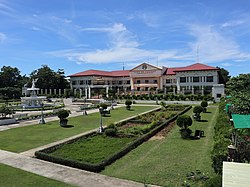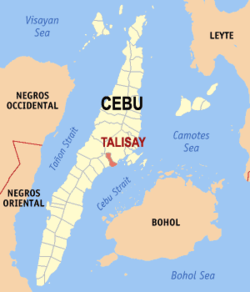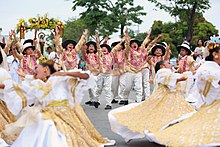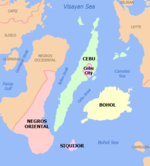Component city in Central Visayas, Philippines
| Talisay | |
|---|---|
| Component city | |
| City of Talisay | |
 Talisay City Hall and Plaza Talisay City Hall and Plaza | |
 Seal Seal | |
| Etymology: Magtalisay trees | |
| Nickname(s): Aquatic City in Cebu The Gateway City of the South | |
| Anthem: Abante Talisay | |
 Map of Cebu with Talisay highlighted Map of Cebu with Talisay highlighted | |
| OpenStreetMap | |
 | |
| Coordinates: 10°15′N 123°50′E / 10.25°N 123.83°E / 10.25; 123.83 | |
| Country | Philippines |
| Region | Central Visayas |
| Province | Cebu |
| District | 1st district |
| Founded | 1648 |
| Chartered | 1849 |
| Cityhood | December 30, 2000 |
| Barangays | 22 (see Barangays) |
| Government | |
| • Type | Sangguniang Panlungsod |
| • Mayor | Gerald Anthony V. Gullas Jr. (NP) |
| • Vice Mayor | Richard Francis F. Aznar (NP) |
| • Representative | Rhea Mae A. Gullas (NP) |
| • City Council |
Members
|
| • Electorate | 148,704 voters (2022) |
| Area | |
| • Total | 39.87 km (15.39 sq mi) |
| Elevation | 108 m (354 ft) |
| Highest elevation | 915 m (3,002 ft) |
| Lowest elevation | 0 m (0 ft) |
| Population | |
| • Total | 263,048 |
| • Density | 6,600/km (17,000/sq mi) |
| • Households | 63,066 |
| Economy | |
| • Income class | 3rd city income class |
| • Poverty incidence | 19.17% (2021) |
| • Revenue | ₱ 1,265 million (2020), 545.5 million (2012), 607.7 million (2013), 602.6 million (2014), 692.1 million (2015), 750.9 million (2016), 872.3 million (2017), 954.8 million (2018), 1,026 million (2019), 1,273 million (2021), 1,631 million (2022) |
| • Assets | ₱ 2,274 million (2020), 1,310 million (2012), 1,347 million (2013), 1,400 million (2014), 1,674 million (2015), 2,101 million (2016), 2,163 million (2017), 2,312 million (2018), 2,261 million (2019), 2,508 million (2021), 2,678 million (2022) |
| • Expenditure | ₱ 1,500 million (2020), 455.6 million (2012), 320.8 million (2013), 496.6 million (2014), 438.3 million (2015), 539.2 million (2016), 779.5 million (2017), 924.5 million (2018), 1,152 million (2019), 1,209 million (2021), 1,625 million (2022) |
| • Liabilities | ₱ 452 million (2020), 204.1 million (2012), 193.5 million (2013), 222.9 million (2014), 263.5 million (2015), 407.8 million (2016), 370.5 million (2017), 483.6 million (2018), 479 million (2019), 620.7 million (2021), 738.3 million (2022) |
| Service provider | |
| • Electricity | Visayan Electric Company (VECO) |
| Time zone | UTC+8 (PST) |
| ZIP code | 6045 |
| PSGC | 072250000 |
| IDD : area code | +63 (0)32 |
| Native languages | Cebuano Tagalog |
| Major religions | Roman Catholicism |
| Feast Day | October 15 |
| Patron saint | Saint Teresa of Avila |
Talisay, officially the City of Talisay (Cebuano: Dakbayan sa Talisay; Filipino: Lungsod ng Talisay), is a component city in the province of Cebu, Philippines. According to the 2020 census, it has a population of 263,048 people, making it the most populous component city in Visayas. The city is applying for a Highly Urbanized City (HUC) status.
The city's name is taken from the talisay tree which is abundant in the area.
History
| This section needs additional citations for verification. Please help improve this article by adding citations to reliable sources in this section. Unsourced material may be challenged and removed. (November 2023) (Learn how and when to remove this message) |
Talisay was founded in 1648 as an estate owned by the Augustinians. In 1849, it was converted into a municipality with its first gobernadorcillo, Silverio Fernandez.
During both the American colonial period and World War II, Talisay served as a haven of colonial military forces. The municipality served as the center of guerrilla intelligence operations for the Philippine resistance movement in Cebu during World War II. The returning United States liberation forces landed on the beaches of Talisay on March 26, 1945. This was part of Operation Victor II which was implemented by General Douglas MacArthur in order to regain the islands of Cebu, Bohol, and Negros from the Japanese soldiers. With the joint efforts of the US forces, the Philippine Commonwealth forces, and the Cebuano guerrillas, Cebu was liberated on March 27, 1945, and the Japanese forces in the province eventually surrendered on August 29. To remember this victory and as an honor to the Cebuano veterans, Philippine Republic Act No. 7280 was enacted in 1992 which declared March 26 of every year a special non-working holiday in the municipality of Talisay, Cebu. Later in 2013, the law was expanded under Republic Act No. 10359, so that the holiday will be celebrated in the entire province of Cebu.
Cityhood
Main article: Cities of the PhilippinesIn 2000, the municipality of Talisay was converted into a city through Republic Act No. 8979. The municipality is now linked to Cebu City via the South Coastal Highway from Lawaan which was opened in 2004. This brought some recent inward investment in the form of subdivisions, but some were hastily planned, and thus were plagued by problems. Conflict occurred between the residents of the mountain barangay of Maghaway and those of Crown Asia's Azienda Milan and Venezia subdivisions.
Geography
Primarily a residential and trading center, Talisay lies within the Metro Cebu area. It is bordered to the north by Cebu City, to the west is the city of Toledo, to the east is the Cebu Strait, and to the south is the town of Minglanilla.
Talisay is 10 kilometres (6.2 mi) from Cebu City, the provincial capital.
Barangays
Talisay is politically subdivided into 22 barangays. Each barangay consists of puroks and some have sitios.
| PSGC | Barangay | Population | ±% p.a. | |||
|---|---|---|---|---|---|---|
| 2020 | 2010 | |||||
| 072250019 | Biasong | 2.5% | 6,482 | 5,542 | ▴ | 1.58% |
| 072250001 | Bulacao | 4.8% | 12,697 | 11,579 | ▴ | 0.93% |
| 072250002 | Candulawan | 1.7% | 4,379 | 3,812 | ▴ | 1.40% |
| 072250020 | Camp IV | 1.3% | 3,305 | 2,258 | ▴ | 3.88% |
| 072250003 | Cansojong | 6.1% | 16,016 | 12,645 | ▴ | 2.39% |
| 072250004 | Dumlog | 6.8% | 17,785 | 12,709 | ▴ | 3.42% |
| 072250005 | Jaclupan | 3.3% | 8,684 | 7,891 | ▴ | 0.96% |
| 072250006 | Lagtang | 5.3% | 13,830 | 10,394 | ▴ | 2.90% |
| 072250007 | Lawaan I | 3.6% | 9,413 | 9,503 | ▾ | −0.10% |
| 072250021 | Lawaan II | 2.3% | 6,033 | 5,625 | ▴ | 0.70% |
| 072250022 | Lawaan III | 4.6% | 12,037 | 10,708 | ▴ | 1.18% |
| 072250008 | Linao | 3.8% | 10,110 | 7,951 | ▴ | 2.43% |
| 072250009 | Maghaway | 2.7% | 7,148 | 6,869 | ▴ | 0.40% |
| 072250010 | Manipis | 0.9% | 2,456 | 1,994 | ▴ | 2.11% |
| 072250011 | Mohon | 4.1% | 10,735 | 9,582 | ▴ | 1.14% |
| 072250012 | Poblacion | 4.8% | 12,756 | 12,107 | ▴ | 0.52% |
| 072250013 | Pooc | 4.4% | 11,699 | 8,912 | ▴ | 2.76% |
| 072250014 | San Isidro | 5.2% | 13,753 | 12,502 | ▴ | 0.96% |
| 072250015 | San Roque | 6.9% | 18,161 | 16,950 | ▴ | 0.69% |
| 072250016 | Tabunok | 5.6% | 14,682 | 17,593 | ▾ | −1.79% |
| 072250017 | Tangke | 5.2% | 13,707 | 11,891 | ▴ | 1.43% |
| 072250018 | Tapul | 0.7% | 1,777 | 1,755 | ▴ | 0.12% |
| Total | 263,048 | 200,772 | ▴ | 2.74% | ||
Climate
| Climate data for Talisay | |||||||||||||
|---|---|---|---|---|---|---|---|---|---|---|---|---|---|
| Month | Jan | Feb | Mar | Apr | May | Jun | Jul | Aug | Sep | Oct | Nov | Dec | Year |
| Mean daily maximum °C (°F) | 28 (82) |
29 (84) |
30 (86) |
31 (88) |
31 (88) |
30 (86) |
30 (86) |
30 (86) |
30 (86) |
29 (84) |
29 (84) |
28 (82) |
30 (85) |
| Mean daily minimum °C (°F) | 23 (73) |
23 (73) |
23 (73) |
24 (75) |
25 (77) |
25 (77) |
25 (77) |
25 (77) |
25 (77) |
25 (77) |
24 (75) |
23 (73) |
24 (75) |
| Average precipitation mm (inches) | 70 (2.8) |
49 (1.9) |
62 (2.4) |
78 (3.1) |
138 (5.4) |
201 (7.9) |
192 (7.6) |
185 (7.3) |
192 (7.6) |
205 (8.1) |
156 (6.1) |
111 (4.4) |
1,639 (64.6) |
| Average rainy days | 13.4 | 10.6 | 13.1 | 14.5 | 24.2 | 27.9 | 28.4 | 27.7 | 27.1 | 27.4 | 22.5 | 15.9 | 252.7 |
| Source: Meteoblue (modeled/calculated data, not measured locally) | |||||||||||||
Demographics
| Year | Pop. | ±% p.a. |
|---|---|---|
| 1903 | 13,636 | — |
| 1918 | 15,302 | +0.77% |
| 1939 | 20,077 | +1.30% |
| 1948 | 22,442 | +1.25% |
| 1960 | 31,097 | +2.76% |
| 1970 | 47,787 | +4.38% |
| 1975 | 55,738 | +3.13% |
| 1980 | 69,720 | +4.58% |
| 1990 | 97,955 | +3.46% |
| 1995 | 120,292 | +3.92% |
| 2000 | 148,110 | +4.56% |
| 2007 | 179,359 | +2.68% |
| 2010 | 200,772 | +4.19% |
| 2015 | 227,645 | +2.42% |
| 2020 | 263,048 | +2.88% |
| Source: Philippine Statistics Authority | ||
In 2017, Talisay City was the most densely populated city in the Cebu province. This ranking does not include highly urbanized cities: Cebu City, Lapu-Lapu, & Mandaue. There were 5,710 people living per square kilometer.
Cebuano is the predominant language of the inhabitants of the city (96%).
Religion

Talisay City has a Roman Catholic majority population. It also has sizeable Protestant and non-Christian minorities.
Economy
Poverty incidence of Talisay
|
5
10
15
20
2006 18.60 2009 17.98 2012 10.65 2015 14.07 2018 8.20 2021 19.17 Source: Philippine Statistics Authority |
As of 2005, Talisay remains an important center for the production of blasting caps used in dynamite.
Much of the commerce in Talisay takes place in the Tabunok area, where several public markets, strip malls, and commercial establishments are situated. The biggest mall is Gaisano Grand Fiesta Mall Tabunok, which has a supermarket, department store, and formerly, a cinema. However, much of the population still depend on the public markets, where they can find fresh meat, fish and vegetables, as well as other household needs. There are many sari-sari stores. Talisay City and the Tabunok area also serve as the commercial area for municipalities south of the city, being the southern gateway to Cebu City.
Culture

Talisay City is considered the "Lechon Capital of Cebu" and is considered one of the two places to get the best of the best Lechon, which is nicknamed "Inasal", in Cebu, with the other place being Carcar.
Because of their Lechon, the town decided to create a religious-cultural festival to promote Talisay City, which was "Halad Inasal Festival" and celebrated on October 15. The festival is in honor of St. Teresa of Avila, Talisay City's patron saint, and is highlighted by street dancing merged with a procession with roasted pig, which then culminates with a ritual showdown and a grand finale with a firework display.
Transport
Talisay City has benefited from the construction of the South Road Properties and the road that traverses it, the Cebu South Coastal Road, which is a six-lane coastal highway from downtown Cebu City to the city's Barangay Lawa-an I, near its border with the town of Minglanilla, with several exits in between, many of which serve several areas of Talisay. Because of this highway, traffic, which has always been a problem for the inhabitants in the past few years for this area, has been greatly reduced, making the city a popular zone for housing once more, as it was in the early 70s and 80s.
The city is also set to be served by the Cebu Bus Rapid Transit, wherein it will have two (2) feeder lines, going to Mambaling and to the South Road Properties, both located in Cebu City.
In 2016, the Talisay city council expressed support for the proposed Light Rail Transit (LRT) project in Cebu.
Education
- 20 Elementary schools (Private & Public)
- 12 Public secondary schools
- 08 Private secondary schools
- Divino Amore Academy (1993) Mohon, Talisay City
- 03 Colleges
- 05 Kindergartens
- 05 Seminaries
References
- "Talisay City Website". www.talisaycitycebu.gov.ph. Archived from the original on June 16, 2006. Retrieved January 12, 2022.
- http://www.coa.gov.ph › Cebu › TalisayCity_Cebu_ES2016
- City of Talisay | (DILG)
- "2015 Census of Population, Report No. 3 – Population, Land Area, and Population Density" (PDF). Philippine Statistics Authority. Quezon City, Philippines. August 2016. ISSN 0117-1453. Archived (PDF) from the original on May 25, 2021. Retrieved July 16, 2021.
- ^ Census of Population (2020). "Region VII (Central Visayas)". Total Population by Province, City, Municipality and Barangay. Philippine Statistics Authority. Retrieved July 8, 2021.
- "PSA Releases the 2021 City and Municipal Level Poverty Estimates". Philippine Statistics Authority. April 2, 2024. Retrieved April 28, 2024.
- "Talisay City History | Tourist Spots, Language and Festivals | Philippines Cities". Retrieved July 10, 2024.
- "Landing in Talisay, Cebu | PVAO". Retrieved July 10, 2024.
 This article incorporates text from this source, which is in the public domain.
This article incorporates text from this source, which is in the public domain.
- NSCB - 2001 Factsheet - 12 New Cities Created, July–December 2000.
- ^ Census of Population and Housing (2010). "Region VII (Central Visayas)" (PDF). Total Population by Province, City, Municipality and Barangay. National Statistics Office. Retrieved June 29, 2016.
- "Talisay: Average Temperatures and Rainfall". Meteoblue. Retrieved May 10, 2020.
- Census of Population (2015). "Region VII (Central Visayas)". Total Population by Province, City, Municipality and Barangay. Philippine Statistics Authority. Retrieved June 20, 2016.
- Censuses of Population (1903–2007). "Region VII (Central Visayas)". Table 1. Population Enumerated in Various Censuses by Province/Highly Urbanized City: 1903 to 2007. National Statistics Office.
- "Poverty incidence (PI):". Philippine Statistics Authority. Retrieved December 28, 2020.
- "Estimation of Local Poverty in the Philippines" (PDF). Philippine Statistics Authority. November 29, 2005.
- "2003 City and Municipal Level Poverty Estimates" (PDF). Philippine Statistics Authority. March 23, 2009.
- "City and Municipal Level Poverty Estimates; 2006 and 2009" (PDF). Philippine Statistics Authority. August 3, 2012.
- "2012 Municipal and City Level Poverty Estimates" (PDF). Philippine Statistics Authority. May 31, 2016.
- "Municipal and City Level Small Area Poverty Estimates; 2009, 2012 and 2015". Philippine Statistics Authority. July 10, 2019.
- "PSA Releases the 2018 Municipal and City Level Poverty Estimates". Philippine Statistics Authority. December 15, 2021. Retrieved January 22, 2022.
- "PSA Releases the 2021 City and Municipal Level Poverty Estimates". Philippine Statistics Authority. April 2, 2024. Retrieved April 28, 2024.
- Bacalla, Philippine Center for Investigative Journalism,Tess. "Coastal city is hub of explosives trade". Philstar.com. Retrieved July 10, 2024.
{{cite web}}: CS1 maint: multiple names: authors list (link) - "R' Cebu Expo Highlights The First District Of Cebu Province". September 6, 2022. Retrieved July 10, 2024.
- "Inasal-Halad Festival". www.cebufest.com. CebuFest. August 26, 2018. Retrieved October 21, 2021.
- Librea, Jerra Mae (September 3, 2019). "DOTR official: New BRT route to extend to Talisay". SunStar Cebu. Retrieved June 12, 2021.
- Sun Star Cebu 2016.
Sources
- Gonzales, Glenda R. (December 2004). "Metro Cebu: A Metropolitan Area in Need of Coordinative Body" (PDF). Discussion Paper. 2004-49. Philippine Institute for Development Studies. Retrieved February 16, 2016.
- Sun Star Cebu, Justin K. Vestil (August 5, 2016). "LRT system gets backing of Talisay council". Archived from the original on August 6, 2016.
External links
| Places adjacent to Talisay, Cebu | ||||||||||||||||
|---|---|---|---|---|---|---|---|---|---|---|---|---|---|---|---|---|
| ||||||||||||||||




